Abstract
A casket held at Bateman’s, Rudyard and Caroline Kipling’s home in Sussex—now a National Trust property—was recently recognised as a barniz brillante work. Objects made of barniz brillante, a technique featuring the Indigenous American material called mopa mopa, are relatively rare and have only sparingly been studied using scientific analysis techniques. A collaboration between the National Trust and the Victoria and Albert Museum has produced scientific evidence which will be invaluable in the study and the understanding of this type of object. The scientific analysis of the casket was conducted exclusively in a non-destructive and non-invasive manner, to preserve the integrity of the object which is in very good condition. The Bateman’s casket is characterised by a dark underdrawing, made with a material which is transparent in the infrared region of the electromagnetic spectrum. Most of the areas decorated with silver leaf have tarnished due to the formation of what is likely to be silver chloride. This study represents a significant step towards the comparative scientific study of barniz brillante objects in other collections, which in turn will make it possible to suggest a timeline for their manufacture, and even identify workshops.
1. Introduction
The National Trust looks after historic properties, historic sites, coastline and countryside in England and Wales and is Europe’s largest conservation charity. The National Trust’s varied collections comprise over 55,000 pieces of furniture and an additional 14,000 items classed as ‘wooden objects’. As such, it is one of the largest and most important collections of furniture and associated items in the world.
Case studies of barniz de Pasto [1] published by the V&A prompted National Trust curators to search its own collections for this material and, in 2021, the first example of barniz de Pasto was identified (NT 761758—Figure 1) at Bateman’s near Burwash, Sussex. This casket is decorated with mopa mopa, a plant resin used in the manufacture of South American barniz de Pasto objects; its decoration, which includes silver leaf, is known more specifically as barniz brillante [2,3].
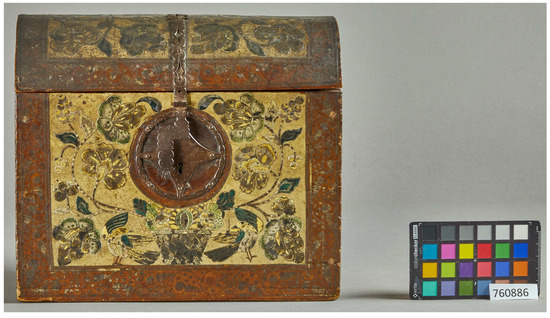
Figure 1.
NT 761758, the South American barniz de Pasto casket, probably 17th century (22.6 cm × 26.2 cm × 13.9 cm), at Bateman’s, Sussex. © National Trust/Laurence Pordes.
1.1. Provenance
Bateman’s (Figure 2) was the home of Rudyard Kipling (1865–1936, Figure 3a), novelist, poet and journalist, and his wife, Caroline ‘Carrie’ Starr Balestier (1862–1939) (Figure 3b), from 1902 until it was left to the care of the National Trust in 1939.

Figure 2.
Bateman’s, near Burwash, Sussex © National Trust Images/Laurence Perry.
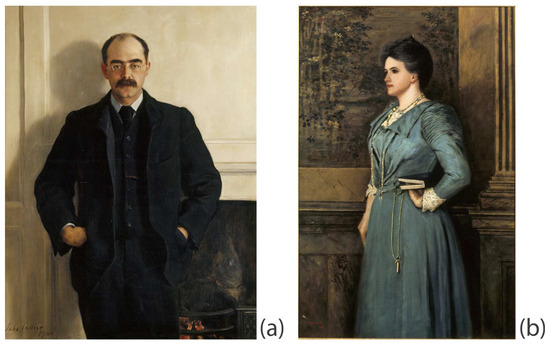
Figure 3.
(a) Rudyard Kipling (1865–1936), by The Hon. Jon Collier (1850–1934), 1900 © National Trust Images/John Hammond and (b) Caroline Starr Balestier, Mrs. Rudyard Kipling (1862–1939), by Sir Philip Edward Burne-Jones (1861–1926), 1899 © National Trust Images/John Hammond.
On Caroline’s death in 1939, some of the house’s contents were inherited by the Kiplings’ daughter, Elsie (1892–1976), who removed them to Wimpole, the house in Cambridgeshire she shared with her husband, George Bambridge (1892–1943). The collections that remain at Bateman’s are diverse, comprising furniture, decorative objects, books and textiles from all over the world, some inherited, but mostly collected by Rudyard and Caroline on their frequent, often extended, trips overseas.
The contents of Bateman’s were inventoried on Caroline’s death, and bequests were listed in a separate schedule which recorded the presence in the Parlour of ‘an old Spanish wood casket with hinged domed top, painted flowers in colours and gilt and mounted with ironwork hinges and hasp’ [4]. This was almost certainly NT 761758, which has remained in the Parlour at Bateman’s ever since (Figure 4); Elsie, for whom the casket was intended, did not—for reasons unknown—take possession of this casket and remove it from Bateman’s.

Figure 4.
The Parlour at Bateman’s, circa 2010, the casket on the table before the window, ©National Trust Images/Andreas von Einsiedel.
The Schedule is the earliest documentary record of the casket at Bateman’s and—describing it as Spanish—may have influenced the way the casket has been considered and catalogued in subsequent years. National Trust guidebooks of 1976, 1983, 1985, 1989, 1995 and 1996 incorrectly describe it as ‘a coloured gessoed box’, neither attributing it to a particular country of origin, nor hazarding a guess at the date when it was made [5,6,7,8,9]. The National Trust’s Collections Management System until recently described the casket as ‘lacquered’, not gessoed, but also declined both to date it or to attribute it to a particular school or country.
A receipt for its purchase has not yet been found: although a substantial archive of Kipling’s correspondence and writing is held by the University of Sussex, with smaller collections elsewhere, he was known as ‘a determined destroyer of personal papers’ and his wife, Carrie, and daughter, Elsie, seem to have taken a similar approach, so there is no evidence at all as to when and where the casket was acquired [10]. Nonetheless, all of the guidebooks provide the same account of when and how the casket came to be at Bateman’s, stating that it was ‘was much treasured by Kipling…[being]… a present from his daughter Elsie, who had bought it while on a visit to her fiancé, Captain George Bambridge, in Spain’ [10]. The source of this anecdote is unknown—it may have been Elsie Bambridge in whose lifetime Bateman’s was transferred to the Trust, who passed it on—and it is modified by the account given in the casket’s record in the Trust’s Collections Management System, which introduces the idea that Elsie bought the casket for her father whilst on honeymoon in Spain in 1927. In this account, either the date or the fact that Elsie bought the casket whilst on honeymoon must be wrong, since she and George Bambridge married in October 1924. There may, however, be a kernel of truth in the idea that the casket was acquired in 1927, because Elsie and George were in Spain that year: George Bambridge was a British diplomat and was posted to Madrid from 1925 to 1928.
It may also be worth noting that Rudyard and Carrie themselves travelled to South America—visiting only Brazil—in February and March of 1927, the year in which some sources say that the box was acquired. Kipling regularly purchased objects on his travels and took a keen interest in how Bateman’s was furnished, even designing the day-bed which is still in his study there [11]. He wrote to his daughter Elsie on 22–23 February 1927 from Brazil, saying that Carrie had ‘been out...looking at old furniture and silver’ that day [10]. However, no further detail is given, and a series of seven travel letters, written for publication and first printed in London in ‘The Morning Post’ in 1927 and then in a collected edition called ‘Brazilian Sketches’, first published in 1940, do not mention the casket either [12].
Divorced from its original setting, and with little documentary evidence describing its arrival in Europe from South America, its physical characteristics are instructive. Four different paper labels suggest that the casket has passed through several hands (Figure 5). Most are worn, but some bear legible letters and digits, albeit their significance is not currently apparent. None of these labels were ever, to our knowledge, used by the National Trust or the Kiplings, and point to its having been in another collection, or collections, or having been handled by a dealer at some point before it was acquired by the Kiplings. It would be interesting to know whether any other barniz de Pasto objects have similar labels, which would indicate an established trade in this type of object, either in South America or Europe, in the 19th and 20th centuries.
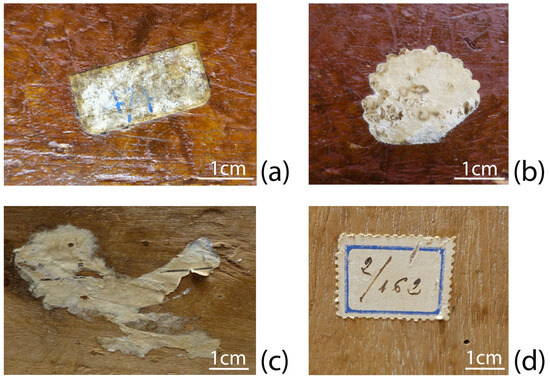
Figure 5.
Paper labels were found on the bottom (a,b) and inside the casket (c,d), © National Trust/Maria Sanchez.
1.2. Research Aim
The aim of this study is to investigate the casket’s materials and techniques of construction. This will be the first step towards further investigations and collaborations focused on barniz brillante objects, which in turn will make it possible to group similar objects and suggest possible production dates or workshops [13]. As part of the investigation on the materiality of the casket, the object was analysed non-destructively and non-invasively at the V&A using infrared reflectography, scanning XRF and digital microscopy [14]. No sampling was allowed, which limited the scope of the research avenues available. The application of the chosen scientific methods of analysis can complement the results of the visual observation of the casket and expand our knowledge about its materiality. In particular, infrared reflectography was intended to highlight the presence of possible underdrawings or preparatory sketches, but also to visualise any later interventions. Scanning XRF was expected to evaluate the distribution of chemical elements on the casket’s surfaces, but also to obtain information on the underlying structure. Digital microscopy was chosen because it can provide a high-resolution record of the various areas of the casket, thereby informing our knowledge about the state of the surfaces, and it is essential to evaluate the craftsmanship and methods of construction of the object. Where the state of the surface allows, digital microscopy is also intended to contribute to our understanding of the stratigraphy of the casket.
The analytical methodology used in this research represents a good example of working in an exclusively non-invasive, non-destructive manner.
2. Materials and Methods
Infrared reflectography (IRR)
IRR was conducted with an Apollo IR Camera (Opus Instruments, UK) sensitive to the near IR wavelengths from 900 to 1700 nm. The camera is equipped with an InGaAs line array sensor, with an area of 125 × 125 px. Images were acquired with a focal aperture of F11 and a focal length of 150 mm. Two tungsten lamps were positioned symmetrically at ~45° with respect to the focal axis of the camera. A 1250 nm Short Wave Pass filter (SWP), a 1250–1510 nm Bandpass filter (BP) and a 1510 nm Long Wave Pass filter (LWP) were also used. Macro IRR images were acquired with a macro lens with a focal aperture of F4.5.
High-resolution digital microscopy
Digital microscopy was performed with a benchtop Hirox HRX-01 digital microscope with a H-1020E attachment was used. The images were acquired with ×10, ×30 or ×90 magnification, polarised ring LED light and multi-focus mode. Raking light was also used. Images were processed with the HRX-01 software version 2.20 and Adobe Photoshop 24.7.0.
Scanning X-ray fluorescence (XRF)
The XRF scans were carried out using a Bruker M6 Jetstream spectrometer equipped with a Rh-target microfocus X-ray tube, and two 60 mm2 XFlash silicon drift detectors (SDD). The X-ray tube was operated at 50 kV and 600 μA. The elemental distribution maps of the table areas were collected with a 100 μm spot size, a 180 μm step size and a dwell time of 55–75 ms/pixel. The X-ray fluorescence spectra were calibrated, fitted and processed using the Bruker M6 Jetstream software version 1.6.758.0.
3. Results and Discussion
3.1. Stylistic Analysis
The decoration on the box consists of a symmetrical design of flowers emanating from a central woven basket with fruits, flanked by birds, all enclosed by a winding foliate border (Figure 1). Typologically, its brillante decoration most closely resembles a group of barniz de Pasto objects including a shallow dish or tray (Figure 6) in the collections of the V&A, dated c. 1650–1750, and attributed to the Viceroyalty of Peru, which is decorated with similar motifs in a similar palette, and a closely comparable meandering foliate border.
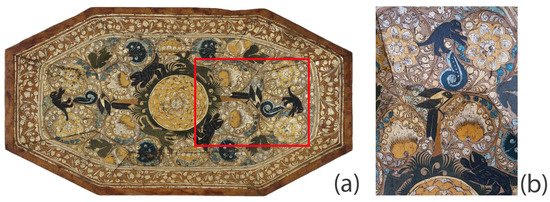
Figure 6.
(a) A barniz de Pasto shallow dish or tray, attributed to the Viceroyalty of Peru, 1650–1750, in the collections of the Victoria and Albert Museum (54 cm × 27.3 cm × 5.5 cm, accession number 1262–1855). (b) A detail of the decorated surface ©Victoria and Albert Museum.
These two pieces, in turn, seem to have been decorated in the same tradition as three writing boxes, two in private collections in Bogota and the third in a private collection in Pasto, discussed by Maria Cecilia Alvarez-White in a paper published in 2019 [15], and a fourth writing box owned by the Hispanic Society Museum and Library, detailed in a paper by Rosa Maria Creixell Cabeza of 2014 [16]. All feature a textured rather than a smooth surface, large flowerheads, woven baskets or jardinieres and birds, and use the same palette of colours and metals. One is conveniently inscribed ‘facto in Quito [Ecuador] en 1709’. Whilst any systematic understanding of where and when exactly these boxes were made has not yet been established, the last example suggests that a provisional date of circa 1700, and a provisional attribution to Quito, are both plausible.
3.2. Construction
The casket is simply constructed: the sides of the box and lid are joined to the front, back and top with wooden nails (Figure 7). Tool marks relating to the construction are visible inside the casket; these include handsaw marks on the bottom and sides, scribe marks on the sides, and gouge marks on the lid. The front is fitted with a lock (the key is missing) and decorative escutcheon, while the lid has a decorative hasp and two ornate iron hinges at the back. By eye wood identification is limited as there are no uncoated areas of end grain. Based on the tangential wood grain pattern, and colour of the exposed interior wood, the timber features are consistent with Spanish cedar (Cedrela odorata), identified in other barniz de Pasto items [2,17,18,19]. To achieve a more informed wood identification, sampling would be required but is not recommended as it would impact the integrity of the casket. Examination of the wooden nails suggests they are all made from bamboo as bamboo’s distinctive pattern of vascular bundles and fibres are easily visible (Figure 7b).
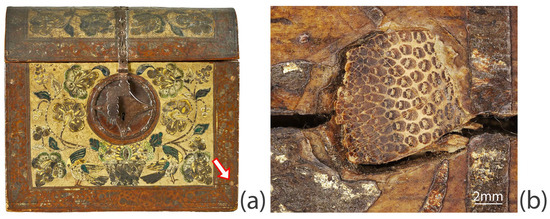
Figure 7.
(a) The front of the casket; (b) detail of the bamboo nail. The arrow marks the position of the nail shown in the closeup.
The structure of the casket is sound despite minor splits related to the location of the wooden nails. The casket also displays evidence of furniture beetle (Anobium punctatum) damage with visible flight holes in the wood and corresponding surface decoration.
The hinges (Figure 8a), lock and hasp have been altered or replaced, as evidenced by gaps where previous hinges would have been. We can also see previous pin holes filled with wood, and the pattern left by these pinholes coincides with differently shaped hinges. On the inside, in the area corresponding to the external hinges, two gaps have been neatly filled and finished with wood (Figure 8b). There is also a circular impression in the centre of the lid, which could be from a previous locking mechanism. Curiously, the inside of the casket also reveals some unexpected features including very regular, horizontal (mechanical) tool marks, a reddish paint on the upper and outer surfaces of the sides and corresponding areas of the lid, as well as several darkened, half-open, furniture larvae channels. Together, these observations suggest that the inside of the casket has had some intervention in the past. Possible explanations of the tool marks, paint and open larvae channels are as follows:
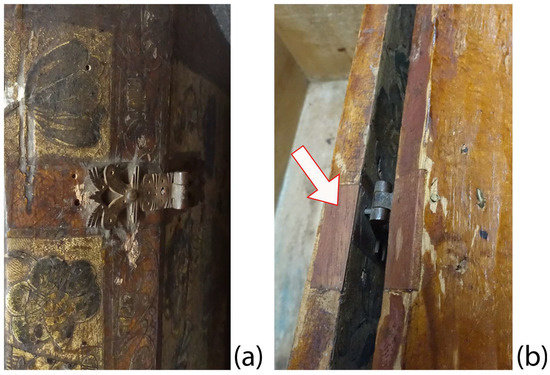
Figure 8.
(a) The hinge on the proper right of the casket; (b) the altered area where wood fills coincide with both external hinges. The arrow marks the location of one of the wood fills.
- There was a liner inside that has been removed and is now missing;
- The maker used wood that had previously had a furniture beetle infestation; thus, when cutting the timber, old larvae channels were revealed;
- The sides were thinned after the casket had an active beetle infestation;
- The outer surfaces and edges of the upper sides rubbed the inner side of the lid, wearing away mopa mopa.
Scanning XRF was used to investigate and image the external surface of the casket. While this was primarily aimed at collecting elemental distribution maps of the decoration, it also provided additional information about the internal structure of the object.
Figure 9 shows the distribution maps of elements in the Compton region (the high-energy region between 17 and 40 KeV), resulting in the observation of the materials constituting the body of the casket, and revealing details which are not visible to the naked eye. In this case, it is possible to view the wooden panels and how they are joined. The wooden nails can be seen clearly, as well as the marks left by other nails which are no longer present. The growth rings of the wood are also visible. It can be observed that the boards are mostly rift or radially cut, suggesting thoughtful craftsmanship—as radial grain orientation minimises the effect of wood movement due to relative humidity fluctuations [20,21]. The lid appears to be hollowed from a single board to obtain the desired curvature.
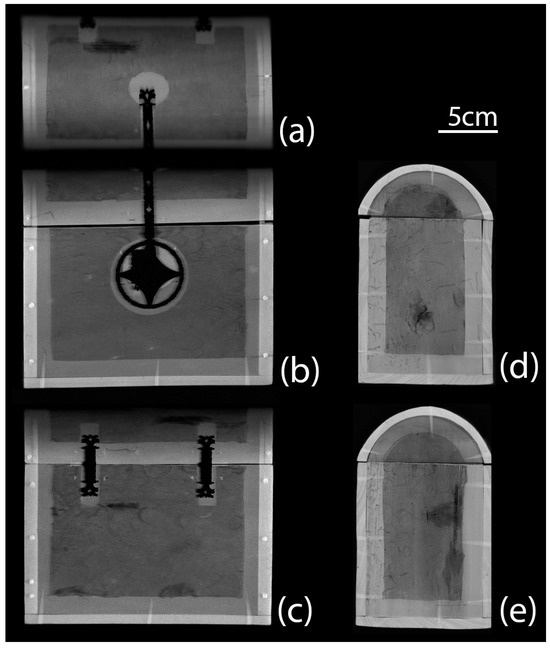
Figure 9.
Scanning XRF distribution maps obtained from the Compton high-energy region (17–40 KeV). (a) top view of the lid, (b) front, (c) back, (d) proper left side and (e) proper right side of the casket.
The XRF scans also show clearly the damage associated with furniture beetle activity and the resulting tunnels. Lastly, tool marks left on the outer wood surface, before the application of the decorative finishes, can be observed. The cross-hatching pattern scored on the wood surface after the assembling of the casket suggests an attempt to increase the adhesion between the substrate and the decorative coatings (Figure 10).
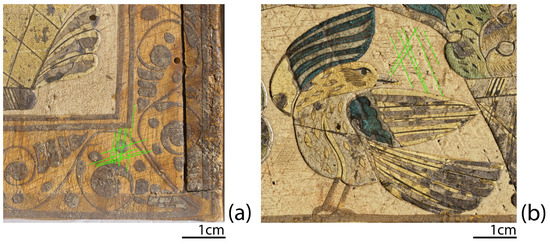
Figure 10.
The cross-hatching marks scoring the wood substrate can be seen under raking light: as an example, see detail of (a) proper left side and (b) front of the casket. Green lines highlight some of the cross-hatching marks.
The cross-hatching marks can be seen by the naked eye even when covered by several layers of barniz de Pasto (Figure 10). Compared with examples in other collections, the casket is distinctive because of the depth of the marks; in other objects, these are not so noticeable, if at all present, or they have, instead, a fabric attached before applying the mopa mopa [13].
The surface of the casket also retains evidence of finger pressure marks and fingerprints left by the craftspeople as they pressed the decorative layers onto the wooden substrate (Figure 11).

Figure 11.
Finger pressure marks and fingerprints cover the surface and are visible under closer inspection. Examples from proper right side: (a) XRF distribution map of lead (La1); (b) detail of distribution map of lead; (c) corresponding visible image.
3.3. Metalwork
The iron fittings are oxidised, although in places they retain areas of shiny, untarnished surface. The question arose as to whether the latter could be due to remnants of silvering—a number of other barniz objects retain the original silver mounts. The XRF investigations carried out on the metal components confirmed that the latter are made of solid iron, with brass nails holding them in place. Manganese was also detected—this is unsurprising because manganese is often found in mineral deposits in combination with iron. No traces of silver could be seen on the surface of the iron fittings (Figure 12).
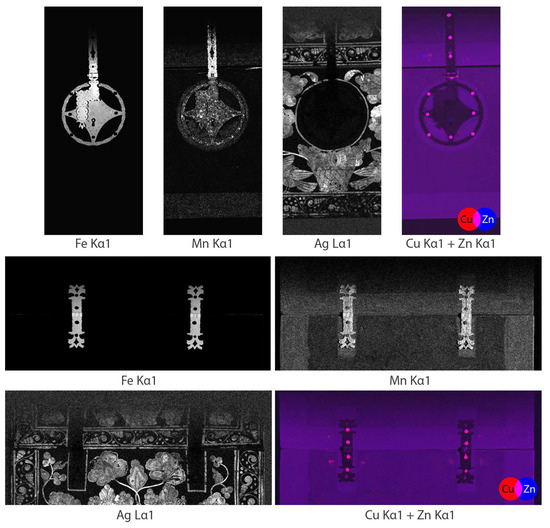
Figure 12.
XRF distribution maps of iron (Fe), manganese (Mn), silver (Ag) and copper (Cu) with zinc (Zn). The silver maps confirm that no silver is present on the metal components, and the copper and zinc maps show that the nails holding the lock and hinges in place are made of brass. Traces of brass from nails used for previous locks and hinges can also be seen, suggesting the outline of previous hardware.
The evaluation of the copper and zinc elemental maps reveals that the nails holding the current lock and hinges in place are made of brass. Intriguingly, traces of previous brass nails can also be seen to the side of the current ones, suggesting that the previous hardware was also held in place with brass nails. The distribution of these traces outlines what would have been the shape and size of previous hardware (Figure 12).
3.4. Decorative Technique
The casket is decorated with barniz brillante, where silver leaf is sandwiched between layers of mopa mopa, providing an additional effect of metallic lustre to the surface (Figure 13) [2,13,22].
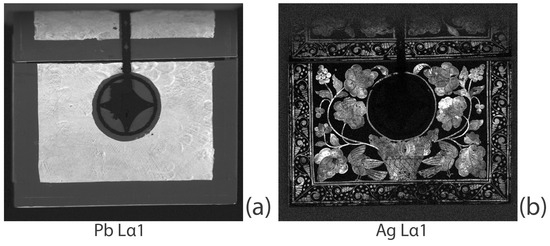
Figure 13.
XRF distribution maps of (a) lead (Pb) and (b) silver (Ag) for the front of the cabinet.
The layer structure is complex, and varies depending on which part of the casket is considered. The initial mopa mopa layer seen on the borders, some of the interior and under the base of the casket is a transparent reddish colour. The centre of the wooden panels has an opaque ivory-coloured layer of mopa mopa, used as a base and background for the barniz brillante decoration. This layer has a high concentration of lead and was probably coloured with lead white (albayalde). Occasionally, a dark layer, which can be described as an underdrawing, is also seen. Silver leaf is then applied where the decorative scheme requires it, and is covered by additional layers of mopa mopa. These protect the silver leaf from tarnishing but are also used decoratively, with some areas coloured in different shades of green, blue and yellow to create a vibrant brillante surface. The overlapping layers create a distinctive textured relief on the surface.
Occasionally, silver leaf is applied in a mosaic fashion, as shown in Figure 14, where some of the silver ‘tesserae’ are still visible, while others have been lost or have tarnished.
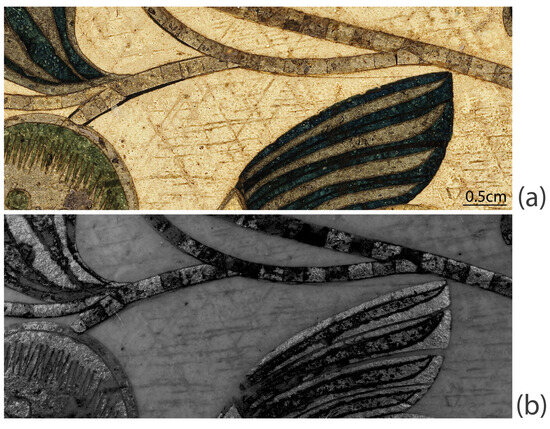
Figure 14.
Detail of the front of the casket, showing an example of silver leaf applied in a mosaic fashion: (a) visible image and (b) infrared reflectography image.
Upon comparison with other items decorated with mopa mopa, it appears that the decorative layers are much thicker in the Bateman’s casket, but this can only be confirmed with invasive methods which are not advocated at this stage.
It is worthwhile noting that the lead-containing layer presents many impurities and small bubbles (Figure 15), but despite this, the lacquer is still well attached to the wood. The origin of the bubbles is uncertain; they could be due to the imperfect purification and preparation of the mopa mopa sheet, but also to the formation over time of lead soaps, which are known to have a disruptive effect on the appearance and integrity of lead-pigmented layers [23,24,25,26,27].
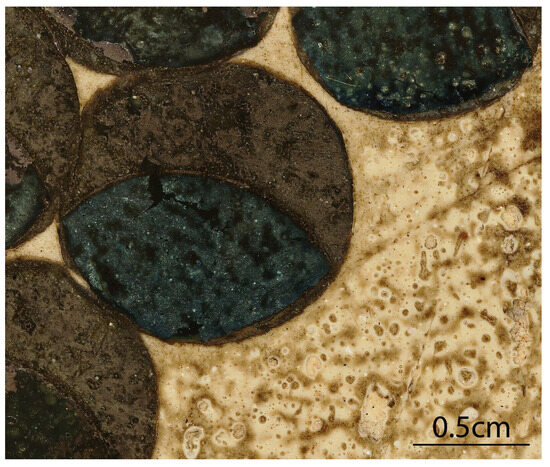
Figure 15.
Detail from the proper left of the casket showing impurities and bubbles in the barniz background.
White pigments on barniz de Pasto objects have historically been identified as containing lead white. Mercury white, i.e., mercury(I) chloride used as a pigment, was only recently identified [2,3,13,18,28,29,30,31]. Only one of the two V&A objects decorated with barniz brillante featured mercury white [32], while the tray shown in Figure 6 does not contain any. Nowhere on the National Trust casket was mercury detected—its presence or absence being one of the issues to be investigated during this study.
3.5. Underdrawing and Outlines
The technical examination of the object also revealed that a dark-coloured material was used with two separate purposes: in the first instance, it served for preparatory purposes, either as an underdrawing or as a tracing medium to reproduce standard motifs of ornamentation; in the second instance, it was used also as a contrasting colour to be revealed as part of the decorative scheme. Under visible light, this material is black or very dark blue, but it is invisible under infrared light, suggesting it could be made of indigo [29,31,33].
Figure 16a shows a detail of the casket viewed under raking light, revealing how the decoration was applied on top of the lead-containing background. Parts of the preparatory underdrawing show, in visible light, under the metal leaf where the latter has been lost (Figure 16b), but it becomes transparent when viewed under infrared light (Figure 16c).
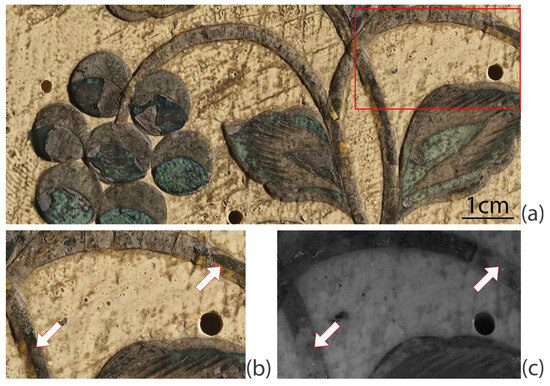
Figure 16.
Details of the proper left of the casket showing traces of a dark underdrawing which is invisible under infrared illumination: (a) raking light visible image; (b) visible image of detail; (c) IRR image of detail. White arrows mark the areas where the underdrawing comes into view.
Figure 17 shows another area where a large portion of silver leaf has been lost, revealing the dark-coloured layer underneath. Nearby, the dark material is also clearly visible, this time as an integral part of the design, where slits of silver leaf have been intentionally cut out. In both instances, the dark material is transparent in infrared reflectography. Figure 18 shows another instance of deliberate cutouts of the silver leaf, revealing the dark layer underneath.
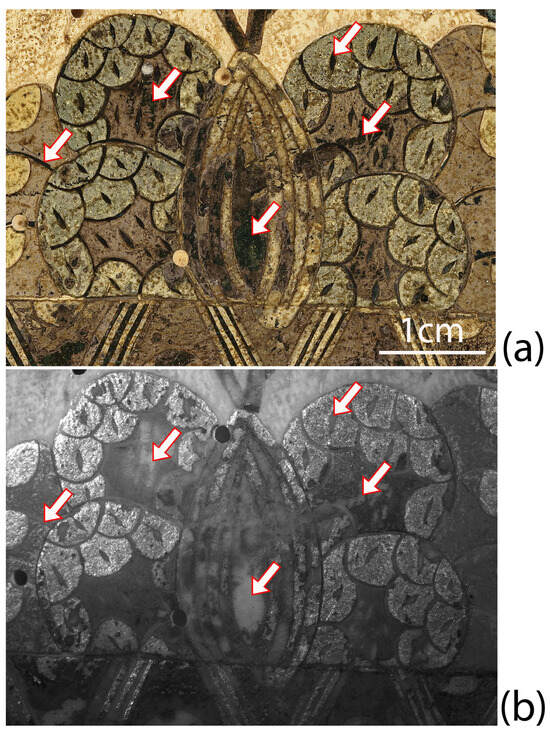
Figure 17.
Detail of the proper left of the casket, with arrows marking the dark-coloured layer underneath the silver leaf: (a) visible image and (b) IRR image.
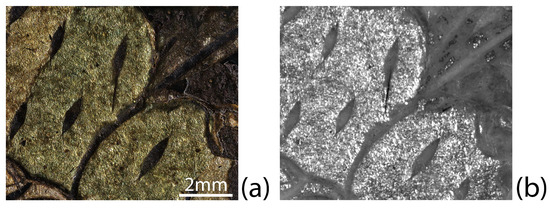
Figure 18.
(a) Detail of the front of the casket, viewed under raking light, showing deliberate cutouts of the silver leaf, which reveal the dark layer underneath. (b) Note how the dark material is transparent in infrared reflectography.
The artist also used an alternative method to enhance the outline of some of the details on the casket, as shown in Figure 19. The lines marked by red arrows refer to details which are dark under both visible (Figure 19a) and infrared (Figure 19b) illumination, suggesting that they likely contain carbon black, finely ground and applied on the incisions of the mopa mopa layers.
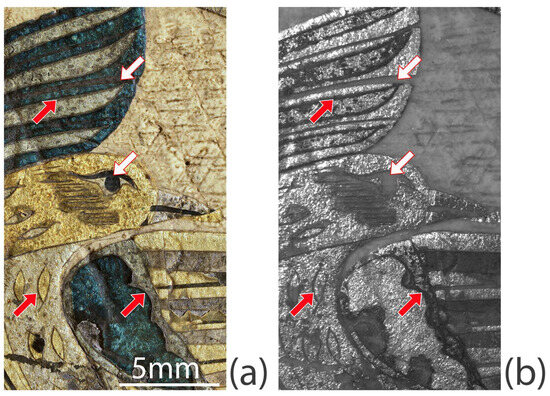
Figure 19.
Detail from the front of the casket, under visible illumination (a) and infrared reflectography (b). Note how the eye and the inner colouring of the wing become transparent under infrared reflectography (white arrows), while the outlines of the wing and the incisions on the cheek of the bird remain visible in both illumination conditions (red arrows).
3.6. Layer Structure of the Decoration
Careful visual observation of the decoration and its damage allows to determine what the original layer structure may have been (Figure 20).
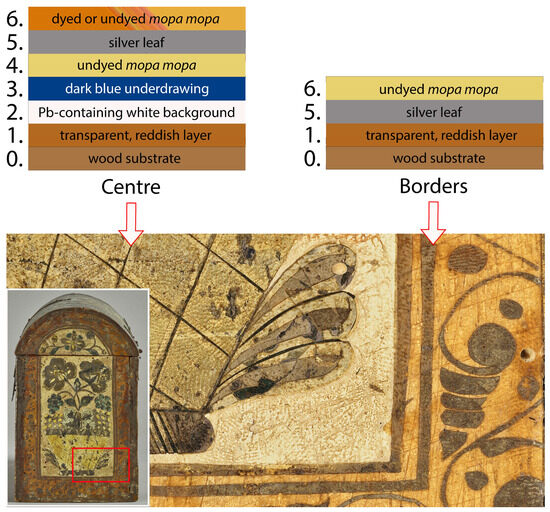
Figure 20.
Simplified stratigraphy of the centre and the border of the casket (top) and close-up of the proper left side of the casket, showing some of the decorative layers.
Where layer 5 remains intact, the silver leaf underneath maintains its glittery appearance due to the presence of mopa mopa, which protects the leaf underneath from tarnishing. This can be seen clearly not only under visible light and to the naked eye, but also in the infrared reflectography images, where the untarnished metal appears bright and white, and the tarnished leaf appears grey.
The XRF elemental maps of the casket show that chlorine is associated with the tarnished silver leaf (see Figure 21b,c).
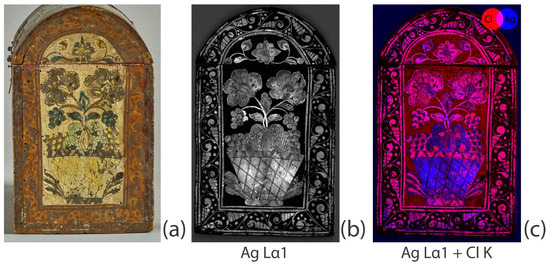
Figure 21.
Proper left side of the casket: (a) under visible light; (b) XRF elemental distribution map of silver (Ag); (c) XRF elemental distribution maps of silver (Ag) and chlorine (Cl).
It can be speculated that the casket was exposed to a chlorine-containing material used as a pest treatment. This would explain the association of silver and chlorine on the tarnished areas of the decoration [34,35] 1. What is unexpected is that there is no sulfur associated with the silver tarnish—silver sulfide usually being the most common corrosion product of silver (more on this matter later). Whilst silver chloride has been found in other analysed examples worldwide, what makes it unique in this example is that there are no clear signs of silver sulfide [36].
Figure 22 shows a close-up of the decorated border. A calcium-containing material (probably gypsum, as supported by the close match between the calcium and sulfur maps) was identified on the surface. The scrollwork was clearly made with silver leaf. The elemental maps show a perfect overlap of silver and chlorine, as seen in other areas of tarnished silver but no match with sulfur can be seen.
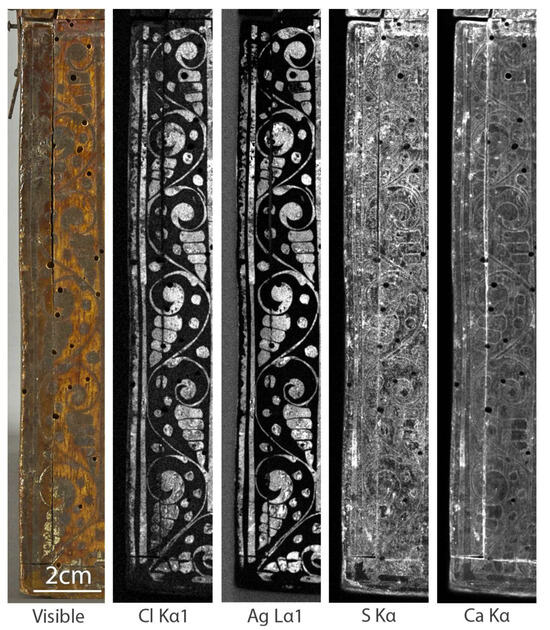
Figure 22.
XRF elemental distribution maps of chlorine (Cl), silver (Ag), sulfur (S) and calcium (Ca), shown with the corresponding visible image of the proper right side of the casket.
3.7. Pest Treatments
At the bottom of the casket, it is possible to distinguish three furniture beetle holes, two of them filled. It is significant that many other insect holes on the casket do not show any sign of past filling, suggesting that there were at least two, if not more, occurrences of pest attack. Thus, we can imagine that when the wood was first attacked by furniture beetles, it was treated with an aqueous solution of copper salts (Figure 23). The treatment was applied to the whole surface and particularly to where the three holes had appeared, so that the liquid penetrated the wood following the wood grain. This can be seen in the copper distribution map. Then, the holes were covered during the decorative process. Copper salts have been used as biocides since antiquity [37]. It is an attractive hypothesis to correlate the presence of copper with the silver corrosion phenomenon.
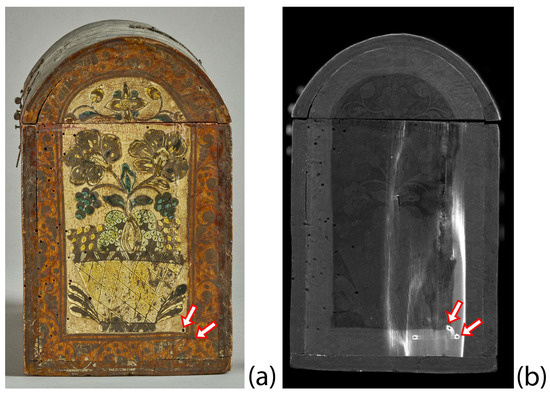
Figure 23.
(a) Visible image of the proper left side of the casket. (b) Scanning XRF elemental distribution maps of copper (Cu) of the proper left side of the casket. Arrows mark two furniture beetle holes.
4. Conclusions
The rediscovery of this casket in the National Trust collection as a barniz brillante object, following a recent flurry of research activities on Indigenous American lacquer, has taken the object out of its previous relative obscurity, and has raised the opportunity for new narratives at Bateman’s.
Work on this casket is very much in progress and there are intriguing aspects, such as the fragmentary labels and the signs of alteration to the metal fittings, which need to be explored further.
The scientific analysis of the casket was conducted exclusively in a non-destructive and non-invasive manner, to preserve the integrity of the object which is in very good condition. We revealed a wealth of information and evidence which is contributing to the growing body of knowledge on this subject area. The most intriguing aspects revealed by the scientific analysis of this object include the presence of a dark underdrawing, likely traced with indigo, as well as the use of incisions and cutouts to reveal an underlying dark layer.
The presence of chlorine in all the tarnished silver areas has been attributed to the formation of silver chloride.
No mercury white was detected on the casket.
A detailed comparison with similar objects in other collections will also need to be considered, in order to build a more complete timeline of the technique of barniz brillante.
Supplementary Materials
The following supporting information can be downloaded at: https://www.mdpi.com/article/10.3390/heritage7030075/s1, Supplementary Material S1: Spanish translation of this paper.
Author Contributions
Conceptualization, L.B., D.M., V.R., M.S.C., E.S. and M.W.; methodology, L.B. and V.R.; formal analysis, L.G. and V.R.; investigation, L.G., L.B., D.M., V.R., M.S.C., E.S. and M.W.; data curation, L.G. and V.R.; writing—original draft preparation, L.G., M.S.C., E.S., M.W., L.B., D.M., V.R., M.S.C., E.S. and M.W.; writing—review and editing, L.G., M.S.C., E.S., M.W., L.B., D.M., V.R., M.S.C., E.S. and M.W. Translation into Spanish: M.S.C. All authors have read and agreed to the published version of the manuscript.
Funding
This research received no external funding.
Data Availability Statement
Original data available on request, where sufficiently justified. The Spanish translation of this paper is available in Supplementary Material S1.
Acknowledgments
The authors would like to acknowledge the assistance of the Royal Oak Foundation for enabling the conservation of this casket; Nick Humphrey (V&A Curator, Furniture and Woodwork) and Maria Cecilia Alvarez-White for generously giving their time and sharing their knowledge as we develop our research, analysis and conservation plan. We are grateful to the UKRI Arts and Humanities Research Council (reference AH/V012134/1) for funding the refurbishment of the V&A science laboratory, including the purchase of the M6 Jetstream spectrometer used for the XRF elemental mapping experiments; of the Apollo IR Camera used for the infrared reflectography experiments; and the Hirox HRX-01 digital microscope used for the digital microscopy.
Conflicts of Interest
The authors declare no conflicts of interest.
Notes
| 1 | It may look counterintuitive that silver chloride as a corrosion product appears dark, when the pure material, when considered in bulk, is white. However, many phenomena occur when corrosion products form on the surface of metals. The combination of these phenomena changes the appearance of tarnished surfaces to the naked eye. Among these phenomena, we can mention thin film interference, the amorphous nature of the corrosion product, and the possible simultaneous presence of silver oxide, which usually appears brown-black, or of other corrosion products. |
References
- Newman, R.; Kaplan, E.; Álvarez-White, M.C. The Story of Elaeagia Resin (Mopa-Mopa), So Far. Heritage 2023, 6, 4320–4344. [Google Scholar] [CrossRef]
- Álvarez-White, M.C.; Cohen, D.; Fernández, M.O. The Splendour of Glitter: Silver Leaf in barniz de Pasto Objects. Heritage 2023, 6, 6581–6595. [Google Scholar] [CrossRef]
- Pozzi, F.; Basso, E.; Katz, M. In search of Humboldt’s colors: Materials and techniques of a 17th-century lacquered gourd from Colombia. Heritage Sci. 2020, 8, 101. [Google Scholar] [CrossRef]
- Schedule of Articles Marked EB in Inventory of Contents of Batemans; The National Trust: Swindon, UK, 1939; p. 1.
- Bateman’s. The National Trust; The Stellar Press: London, UK, 1985. [Google Scholar]
- Bateman’s. The National Trust; BAS Printers Limited: Salisbury, UK, 1989. [Google Scholar]
- Bateman’s. The National Trust; BAS Printers Limited: Salisbury, UK, 1991. [Google Scholar]
- Bateman’s. The National Trust; BAS Printers Limited: Salisbury, UK, 1993. [Google Scholar]
- Bateman’s. The National Trust; BAS Printers Limited: Salisbury, UK, 1995. [Google Scholar]
- Kipling, R. The Letters of Rudyard Kipling; University of Iowa Press: Iowa City, IA, USA, 1990; Volume 5. [Google Scholar]
- An Oak Day-Bed Designed by Rudyard Kipling and Made by Leslie Cope Cornford (1867–1927) in 1902. Available online: https://www.nationaltrustcollections.org.uk/object/760885 (accessed on 27 July 2023).
- Kipling, R. Brazilian Sketches; Canelo: London, UK, 2016. [Google Scholar]
- Álvarez-White, M.C. El Barniz de Pasto: Secretos y Revelaciones; Universidad de los Andes: Cundinamarca, Colombia, 2023. [Google Scholar]
- Geminiani, L.; Risdonne, V.; Burgio, L. V&A Internal Analysis Report 23-24-LG-VR-LB Analysis of National Trust Casket NT760886; Victoria and Albert Museum: London, UK, 2023. [Google Scholar]
- Alvarez-White, M.C. El Barniz de Pasto: Reflejo de la Naturaleza. In Naturaleza y Paisaje. X Encuentro Internacional Sobre Barroco; Fundación Visión Cultural: Valparaiso, Chile, 2019. [Google Scholar]
- Cabeza, R.M.C. Entre el Viejo y el Nuevo Mundo: El escritorio de barniz de pasto de la colección de artes decorativas de The Hispanic Society of America. Res. Mobilis 2014, 3, 119–131. [Google Scholar] [CrossRef][Green Version]
- Cabinet. Available online: https://collections.vam.ac.uk/item/O1296371/cabinet-unknown/ (accessed on 9 December 2023).
- Humphrey, N.; Burgio, L.; Melchar, D. One small corner of the Viceroyalty in South Kensington: Barniz de Pasto at the Victoria and Albert Museum, London. In Anales del Museo de América; Subdirección General de Documentación y Publicaciones: Madrid, Spain, 2020. [Google Scholar]
- Hoadley, R.B. Understanding Wood: A Craftsman’s Guide to Wood Technology; Taunton Press: Newtown, CT, USA, 2000. [Google Scholar]
- Bratasz, Ł. Allowable microclimatic variations for painted wood. Stud. Conserv. 2013, 58, 65–79. [Google Scholar] [CrossRef]
- Jakieła, S.; Bratasz, Ł.; Kozłowski, R. Numerical modelling of moisture movement and related stress field in lime wood subjected to changing climate conditions. Wood Sci. Technol. 2008, 42, 21–37. [Google Scholar] [CrossRef]
- Historia del Reino de Quito en la America Meridional. Tomo 1, Year 1789, Quito; Imprenta del Gobierno: Quito, Ecuador, 1844; Volume 1.
- Keune, K.; Boon, J.J. Analytical imaging studies of cross-sections of paintings affected by lead soap aggregate formation. Stud. Conserv. 2007, 52, 161–176. [Google Scholar] [CrossRef]
- Lead Soaps. Available online: https://www.metmuseum.org/about-the-met/conservation-and-scientific-research/projects/lead-soaps (accessed on 9 December 2023).
- Casadio, F.; Keune, K.; Noble, P.; Van Loon, A.; Hendriks, E.; Centeno, S.A.; Osmond, G. Metal Soaps in Art; Springer: Cham, Switzerland, 2019. [Google Scholar]
- Centeno, S.A.; Mahon, D. The chemistry of aging in oil paintings: Metal soaps and visual changes. Metrop. Mus. Art Bull. 2009, 67, 12–19. Available online: https://www.jstor.org/stable/40588562 (accessed on 25 January 2024).
- Higgitt, C.; Spring, M.; Saunders, D. Pigment-medium interactions in oil paint films containing red lead or lead-tin yellow. Natl. Gallery Tech. Bull. 2003, 24, 75–95. [Google Scholar]
- Burgio, L.; Melchar, D.; Strekopytov, S.; Peggie, D.A.; Di Crescenzo, M.M.; Keneghan, B.; Najorka, J.; Goral, T.; Garbout, A.; Clark, B.L. Identification, characterisation and mapping of calomel as ‘mercury white’, a previously undocumented pigment from South America, and its use on a barniz de Pasto cabinet at the Victoria and Albert Museum. Microchem. J. 2018, 143, 220–227. [Google Scholar] [CrossRef]
- Melchar, D.; Burgio, L.; Fernandez, V.; Keneghan, B.; Newman, R. A collaborative, multidisciplinary and multi-analytical approach to the characterisation of barniz de Pasto objects from the V&A collections. In Transcending Boundaries: Integrated Approaches to Conservation. ICOM-CC 19th Triennial Conference Preprints, Proceedings of the ICOM-CC, Beijing, China, 17–21 May 2021; International Council of Museums: Paris, France, 2021. [Google Scholar]
- Burgio, L. Mercury White’: A Rare Artists’ Pigment? Available online: https://www.vam.ac.uk/blog/caring-for-our-collections/mercury-white-a-rare-artists-pigment (accessed on 9 December 2023).
- Ledesma, A.S. Análisis de los materiales de una arqueta decorada con barniz de Pasto, perteneciente a la colección del Museo de América de Madrid. In Anales del Museo de América; Subdirección General de Documentación y Publicaciones: Madrid, Spain, 2020; ISSN 2340-5724. [Google Scholar]
- Casket, W. 7-2018. Available online: https://collections.vam.ac.uk/item/O1438719/casket/ (accessed on 31 January 2024).
- Ricciardi, P.; Patterson, C.S. Science of the Book: Analytical Methods for the Study of Illuminated Manuscripts. In A Handbook of the Art and Science of Illuminated Manuscripts; Harvey Miller/Brepols: London, UK; Turnhout, Belgium, 2020; pp. 51–87. [Google Scholar]
- Salem, Y. The Influence of Gaseous Pollutants on Silver Artifacts Tarnishing. Open J. Air Pollut. 2017, 6, 135–148. [Google Scholar] [CrossRef][Green Version]
- Thickett, D. Effects of Light on Silver Tarnishing. In Between Material Conservation and Identity Preservation—The (Sacred) Life of Medieval Liturgical Books, Proceedings of the ICOM Committee for Conservation 16th Triennial Meeting, Lisbon, Portugal, 19–23 September 2011; Critério Artes Gráficas, Lda.: Lisbon, Portugal, 2011; ISBN 978-989-97522-0-7. [Google Scholar]
- Villanueva, A.A. Arquetas de barniz de Pasto en la catedral de Pamplona. Estudio y tratamiento. In Anales del Museo de América; Subdirección General de Documentación y Publicaciones: Madrid, Spain, 2020; ISSN 2340-5724. [Google Scholar]
- Kingsland, L.F. Wood Preservation. For. Chron. 1956, 32, 411–416. [Google Scholar] [CrossRef]
Disclaimer/Publisher’s Note: The statements, opinions and data contained in all publications are solely those of the individual author(s) and contributor(s) and not of MDPI and/or the editor(s). MDPI and/or the editor(s) disclaim responsibility for any injury to people or property resulting from any ideas, methods, instructions or products referred to in the content. |
© 2024 by the authors. Licensee MDPI, Basel, Switzerland. This article is an open access article distributed under the terms and conditions of the Creative Commons Attribution (CC BY) license (https://creativecommons.org/licenses/by/4.0/).